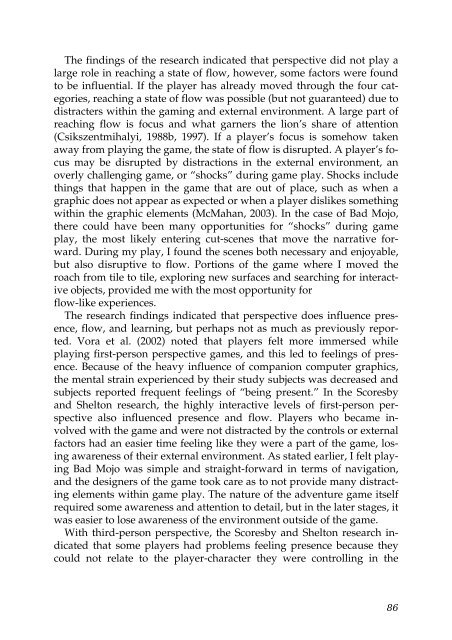Well Played 2.0: Video Games, Value and Meaning - OpenLibra
Well Played 2.0: Video Games, Value and Meaning - OpenLibra
Well Played 2.0: Video Games, Value and Meaning - OpenLibra
Create successful ePaper yourself
Turn your PDF publications into a flip-book with our unique Google optimized e-Paper software.
The findings of the research indicated that perspective did not play a<br />
large role in reaching a state of flow, however, some factors were found<br />
to be influential. If the player has already moved through the four categories,<br />
reaching a state of flow was possible (but not guaranteed) due to<br />
distracters within the gaming <strong>and</strong> external environment. A large part of<br />
reaching flow is focus <strong>and</strong> what garners the lion’s share of attention<br />
(Csikszentmihalyi, 1988b, 1997). If a player’s focus is somehow taken<br />
away from playing the game, the state of flow is disrupted. A player’s focus<br />
may be disrupted by distractions in the external environment, an<br />
overly challenging game, or “shocks” during game play. Shocks include<br />
things that happen in the game that are out of place, such as when a<br />
graphic does not appear as expected or when a player dislikes something<br />
within the graphic elements (McMahan, 2003). In the case of Bad Mojo,<br />
there could have been many opportunities for “shocks” during game<br />
play, the most likely entering cut-scenes that move the narrative forward.<br />
During my play, I found the scenes both necessary <strong>and</strong> enjoyable,<br />
but also disruptive to flow. Portions of the game where I moved the<br />
roach from tile to tile, exploring new surfaces <strong>and</strong> searching for interactive<br />
objects, provided me with the most opportunity for<br />
flow-like experiences.<br />
The research findings indicated that perspective does influence presence,<br />
flow, <strong>and</strong> learning, but perhaps not as much as previously reported.<br />
Vora et al. (2002) noted that players felt more immersed while<br />
playing first-person perspective games, <strong>and</strong> this led to feelings of presence.<br />
Because of the heavy influence of companion computer graphics,<br />
the mental strain experienced by their study subjects was decreased <strong>and</strong><br />
subjects reported frequent feelings of “being present.” In the Scoresby<br />
<strong>and</strong> Shelton research, the highly interactive levels of first-person perspective<br />
also influenced presence <strong>and</strong> flow. Players who became involved<br />
with the game <strong>and</strong> were not distracted by the controls or external<br />
factors had an easier time feeling like they were a part of the game, losing<br />
awareness of their external environment. As stated earlier, I felt playing<br />
Bad Mojo was simple <strong>and</strong> straight-forward in terms of navigation,<br />
<strong>and</strong> the designers of the game took care as to not provide many distracting<br />
elements within game play. The nature of the adventure game itself<br />
required some awareness <strong>and</strong> attention to detail, but in the later stages, it<br />
was easier to lose awareness of the environment outside of the game.<br />
With third-person perspective, the Scoresby <strong>and</strong> Shelton research indicated<br />
that some players had problems feeling presence because they<br />
could not relate to the player-character they were controlling in the<br />
86

















